|
SpaceTides
Newsletter #34
- 18 August 2005
Internet
Newsletter of ASSA Bloemfontein Centre,
South Africa, to the public
www.assabfn.co.za/spacetides
|
In this issue of SpaceTides
|
INDEX
1. Spaceflight news from
around the world
2. Astronomy news from around the world
3.
Interesting space facts
4. Space questions
5. Sky Observation log
6.
Astronomy in Southern Africa
7. Astronomy events in the City of Bloemfontein
8. Web links & Net nodes
|
Dear
SpaceTides subscribers
We
can take a sigh of relief after the Shuttle Discovery landed safely
on Earth. Much depended on the mission's success: not only
the future of the Shuttle program but also the construction progress
of the International Space Station. The success did come at a price
though: hundreds of millions of dollars were spent on making the
shuttle safe, which lifted a few skeptical eyebrows. The viability
of the Shuttle is now very much in dispute - should NASA continue
to spend all these dollars on a (probably obsolete) Shuttle, or
should they rather have started working on a replacement a long
time ago?
In other
news: the Mars Reconnaissance Orbiter has been launched! This satellite
carries highly sophisticated equipment and I think we can look forward
to more interesting finds about Mars in the years to come...
Gerrit Penning
Editor
Total subscribers as at 18 August 2005: 262 (+49 from
previous issue, no. 33)
|
|
1. Spaceflight news from around the world
|
|
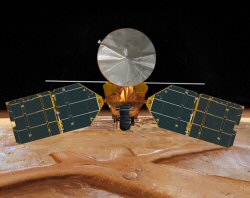
Digitally
rendered picture: MRO. NASA/JPL
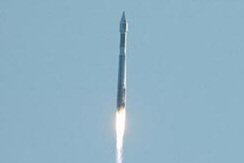
Launch
vehicle of the MRO. NASA/KSC
|
Mars Reconnaissance Orbiter launched
From
JPL News release:
August 12, 2005
The much anticipated launch of
the Mars Reconnaissance Orbiter took place on 12 August 2005, putting
the satellite on a 7 month journey to the mysterious red planet.
The craft will focus on Mars using state of the art equipment and
also assist future landers.
The orbiter is any gadget-man's
dream machine: it carries six highly advanced scientific instruments
for examining Mars's surface, atmosphere and subsurface in extreme
detail from low orbit. According to the JPL website (link below),
"its high-resolution camera will reveal surface features
as small as a dishwasher. NASA expects to get several times more
data about Mars from the orbiter than from all previous Martian
missions combined."
The orbiter's studies will also
include research on past water distribution on Mars and climate
changes and will further assist in helping to answer the question
whether Mars ever supported life or not.
MRO
Homepage:
www.nasa.gov/mro
Information obtained from:
www.jpl.nasa.gov/news/news.cfm?release=2005-133
|
__________________________________________________________________________________________________________________
|
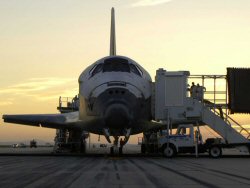
Discovery on runway. NASA/Carla Thomas
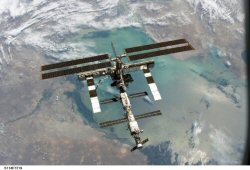
The
International Space Station in August 2005 - NASA
|
Discovery Returns to Earth
From
STS-114 MCC Status Report #28, NASA, August
9, 2005
The
Space Shuttle takes on many forms during a standard mission. It
launches like a rocket, ferries astronauts to space like a shuttle
craft, orbits the Earth while in space like a satellite, returns
to Earth like a glider and lands like an aircraft.
On August 9, 2005, Shuttle Discovery glided into
Edwards Air Force Base in California,
completing a successful mission to the International Space Station.
Thunderstorms at the primary landing site in Florida resulted in Discovery having to land
at its Californian landing site. It will now have to be piggy-backed
on one of NASA's special Boeing 747 transporter planes for a return
flight to its homebase, the Kennedy Space
Centre.
Astronauts
Noguchi and Robinson did three successful spacewalks at the International
Space Station and Discovery transported tons of equipment and supplies
to and from the Station.
Information obtained from: www.nasa.gov/returntoflight/news/STS-114-28.html
More pictures, follow archive link from: www.nasa.gov/returntoflight/main/index.html
|
|
2. Astronomy news from around the world
|
|
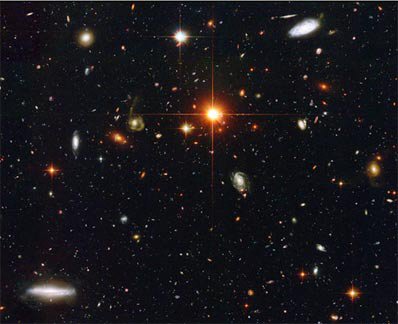
Find high resolution images at: Hubble
Heritage Site - 2005/20 Information from: Hubble
Heritage Site
Image
credit: NASA, ESA, and The Hubble Heritage
Team (STScI/AURA)
|
Another exquisite
photo of galaxies taken by Hubble
(news release on 4 August 2005)
NASA's Hubble Space Telescope gazed deep into the Universe
and captured another mind-boggling view of distant galaxies. The
galaxies visible on this composite image are within the same tiny
region of space and contains a variety of different galaxies
with different characteristics.
The light
coming from these galaxies started their journey billions of years
ago. Here Hubble is looking billions of years back into the past!
The image represents a typical view of our distant universe. Spiral
galaxies, barred spirals, ellipticals and other exotic galaxies are all visible in
this tiny area of the sky.
The image
took nearly 40 hours to complete and is one of the longest exposures
ever taken by Hubble.
|
|
3. Interesting Space Facts
|
|
- Space Shuttle: Each of the three Space Shuttle
orbiters now in operation - Discovery, Atlantis and Endeavour is
designed to fly at least 100 missions. So far they have flown a
combined total of less than one-fourth of that.
http://www.nasa.gov/returntoflight/system/system_STS.html
- The
Hubble Space Telescope: NASA named the world's first space-based
optical telescope after American astronomer Edwin P. Hubble (1889-1953).
Dr. Hubble confirmed an "expanding" universe, which provided
the foundation for the Big Bang theory. http://hubblesite.org/reference_desk/facts_.and._figures/quick_facts/
-
The atmosphere of Mars is composed primarily of carbon dioxide
with small amounts of other gases. Its air contains only about
1/1,000 as much water as Earth's, but even this small amount can
condense out to form swirling clouds. http://www.solarviews.com/eng/mars.htm
-
We live in a giant spiral galaxy,
called the Milky Way Galaxy. It is about 100,000 light-years
in diameter (light takes 100,000 years to move from the one side
to the other). Our Sun is about two thirds from the centre. Two
dwarf galaxies ("satellites" of the Milky Way), are called
the Small Magellanic and Large Magellanic
Clouds and can be seen with the naked eye in the southern hemisphere.
The nearest large spiral to the Milky Way Galaxy is called
the Andromeda Galaxy and is about 2.2 million light-years
away! The Andromeda Galaxy is the farthest object that you can see
with your naked eye - being just above the evening's northern horizon
in spring to early summer for its southern hemisphere observers.
|
|

|
Are there planets around other stars?
In
our Milky Way Galaxy alone there are about 200 to 400 billion stars
(compare that to 6.3 billion people on Earth...)
There are billions of galaxies in the Universe, each containing
many billions of stars. Trillions of planets may orbit around these
stars. In fact, astronomers have already discovered 155 such planets
as at 13 June 2005. These planets are called "exoplanets".
www.exoplanets.org
All those
discovered thus far are believed to be huge gas planets like Jupiter
and Saturn. Improved technology (including even orbital telescopes)
will have to be used to detect rocky earth-like planets. Image at left: Artist's impression - Art of Greg Martin
|
|
 Rocket
launch, NASA EED Rocket
launch, NASA EED
|
How fast must
an object move to escape the Earth's gravitational pull?
For
an object to be able to escape the Earth's gravitational pull (e.g.
a rocket), it must be moving at or above the Earth's escape velocity.
Escape velocity is the speed an object needs to achieve to
escape the gravitational pull of another object. Earth's
escape velocity is about 11 km/s. If a cricket batsman can hit a
ball so hard that it moves at an unrestricted 11 km/s through the
atmosphere, the ball should be able to enter an orbit around the
Earth. A black hole for instance, is an object so compact
that, within a certain distance of it, even the speed of light is
not fast enough to overcome its escape velocity! Info from: http://hubblesite.org/reference_desk/faq/answer.php.id=60&cat=exotic
|
|

Left: The planet Jupiter, image compiled
from various stacked photos taken with an LPI Imager. Credit:
Shaun Twigge, ASSA Bloemfontein Centre.
|
|
Planets in the evening, a planet in the morning
Shining brightly in the evening sky (August 2005) is the
planet Venus
near the western horizon during and just after
sunset (you cannot miss it!). Venus is also referred to as the "evening
star" or "morning star". It is though, not a star
at all, but the planet second farthest from the Sun. Telescope owners
can even attempt to observe the "phases" of Venus.
Just to
the north-east ("upper right") of Venus, is the largest
planet in our solar system, namely Jupiter (see image at
left). Jupiter is currently situated in the constellation of Virgo,
between the stars alpha and gamma Virginis (Spica and Porrima).
Shining
brightly in Aries is the planet Mars. Mars fills the morning
sky with its peculiar red colour and cannot be missed. For the early
birds: have a look outside and see if you can catch a glimpse of
Mars!
|
|
6. Astronomy in Southern Africa
|
|
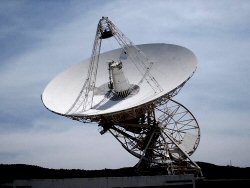
Go
to HartRAO's website at:
http://www.hartrao.ac.za/
|
Hartebeesthoek Radio Astronomy Observatory
The
Hartebeesthoek Radio Astronomy Observatory (HartRAO) is located to the west of Johannesburg in a valley in the Magaliesberg hills. It
operates under the auspices of the National
Research Foundation (NRF).
It
is the only major radio astronomy observatory in Africa.
It began as Deep Space Station 51, built in 1961 by NASA. The station tracked
many unmanned US
space probes. The station was handed over to the CSIR in 1975 and
was converted to a radio astronomy observatory. The main reflecting
surface of the telescope is 26 metres
in diameter (left) and the installation weighs 260 tons.
|
For
other SA Astronomy websites, go to the SpaceTides SA Astronomy
Portal at:
www.assabfn.co.za/spacetides/sa_astronomy.htm
|
7. Astronomy Events in the City of Bloemfontein
|
The
different astronomy organizations in the City, working hand-in-hand
to inform people about the interesting
world of astronomy and spaceflight, can be reached at the following contact
details:
|

|
Explore Boyden Observatory:
www.assabfn.co.za/friendsofboyden/explore.htm
One
of the most publicly accessible observatories of its kind in the
Southern Hemisphere, also housing SA's
third largest telescope. The next open evening is on 10
September 2005 (Saturday). To arrange group visits to the Observatory,
phone Dr. Matie Hoffman at 051-401 2924 for more information, or send
an e-mail to him at: HoffmaMJ.SCI@mail.uovs.ac.za
|
|

|
The Friends of Boyden: www.assabfn.co.za/friendsofboyden
A public interest group for Boyden Observatory and for people
interested in joining the astronomical community of
Bloemfontein, but not
make astronomy their "full-time" hobby. Next
Friends of Boyden meeting: Saturday, 20 August 2005. Phone 084
429 9080 for more information.
Contact Braam van Zyl
at 051-436 7555 (h) or visit the website above for more information
regarding the Friends. Anyone can become a member. R50 membership
fee per year for a whole family. Members receive the latest information
on astronomy events in Bloem, attend the Friends' presentations free of charge
and receive the "Naghemel" quarterly
newsletter compiled by ASSA Bloemfontein by post.
|
|

|
ASSA
Bloemfontein Centre:
www.assabfn.co.za
Affiliated with the Astronomical Society of Southern Africa, the
Bloemfontein Centre of ASSA is an active organization of amateur
astronomers meeting on a regular basis to discuss and practise
astronomy. Activities include solar-, lunar-, deep sky- and comet
& meteor observations, as well as historical research, telescope
building, tours and away-weekends under dark skies. Send an e-mail
to mail@assabfn.co.za or visit the website.
Interested persons can also contact Phillip Coetzer:
084 627 7626.
|
Onthou ook
om Boyden Sterrewag
se gereelde sterrekunde
berigte in die "Ons Stad" plaaslike koerant te lees.
Dit bevat ook meer
inligting rakende
Boyden besoektye.
SpaceTides is a free internet e-zine for persons interested in expanding their
general knowledge of astronomy and spaceflight.
The e-zine originates from the City of Bloemfontein in South Africa and
is compiled us a service to the public by ASSA Bloemfontein Centre
as part of their educational outreach activities. Website: www.assabfn.co.za.
SpaceTides contains links to various other third party sites on the
internet, not always connected to SpaceTides. The persons and entities
responsible
for compiling SpaceTides will not be held responsible for the content
or information on these third party sites or any damage of any kind
incurred from
downloading, opening, or viewing anything from/through these sites.
If you would like to unsubscribe from SpaceTides, send an e-mail
to spacetides@assabfn.co.za with the word
"Unsubscribe" in the subject line.
|



